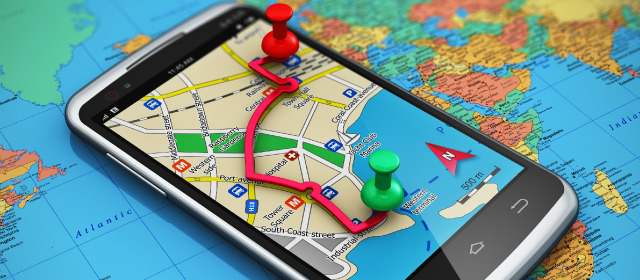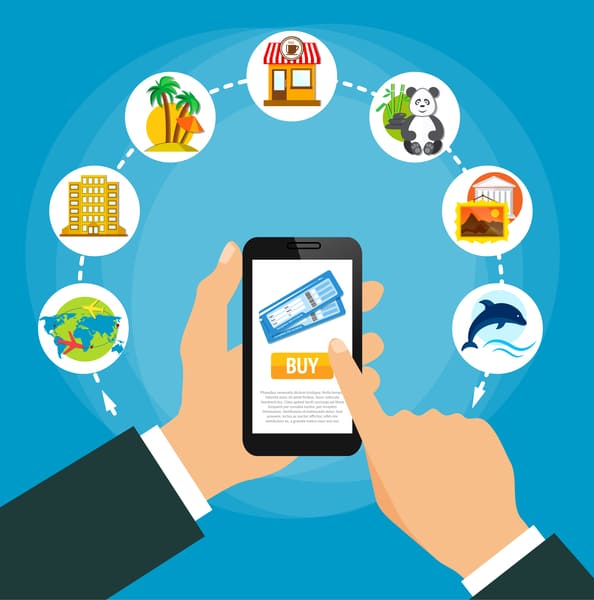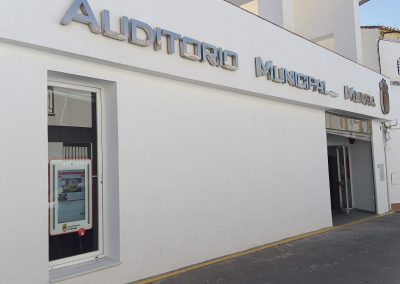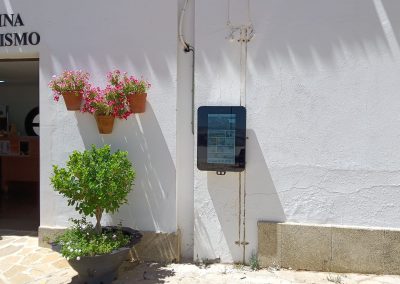Smart tourism destinations: everything you need to know to make your town one

Definition of a smart tourism destinations
If you want to take a closer look at the definition of a smart destination, it can be defined as a geographical area or zone of tourist interest.
In most cases these are a city, province or region that has implemented a strategy for efficiency and sustainability rooted that’s in data and technology.
The most widely accepted definition is the one provided by the Subcommittee for the Standardisation of Smart Tourism Destinations: “A tourism-oriented and innovative space accessible to all, which is consolidated on a cutting-edge technological infrastructure, which must guarantee sustainable territorial development.
It should also facilitate visitor interaction and integration with the environment, increasing the quality of their experience in the destination and the quality of life of the residents.”
How do smart destinations develop?
Tourism has been evolving over the last few decades towards comprehensive quality, encompassing aspects that go beyond the tourism offer of tourism-oriented products and services. Other considerations, both technological and in terms of the impact on the local area, are being factored in when it comes to qualifying destination.
A tourist destination that has a disproportionate impact on the environment, that isn’t accessible to a wide variety of visitors, that doesn’t promote a better quality of life for its inhabitants, or that isn’t competitive and profitable, is not a destination moving towards tourism excellence.
And it is this approach that goes beyond the traditional idea of tourism that transforms the concept of what effective tourism management should mean.
The World Tourism Organisation (WTO) defines sustainable tourism as “tourism that takes full account of its current and future economic, social and environmental impacts, addressing the needs of visitors, the industry, the environment and host communities”.
When it comes to Spain, the Plan Futures, the PICTE (Comprehensive Plan for the Quality of Spanish Destinations) and initiatives like “Green Municipality” changed the foundations of the tourism industry in the 1990s.
At the end of this decade, the University of Pennsylvania launched the “Project Cities” study on smart territories, and the industry started to coin terms like “smart places”.
The “digital cities” project, considered the precursor of what we know today as a smart city, emerged in the 2000s.
All these factors have come together to define what we know today as smart destinations.

How to turn your destination into a smart destination?
The first step in turning your town or city into a smart destination is to apply to join the Smart Tourism Destinations Network, an organisation that brings together institutions and private companies awarded the “DTI” (smart tourism destination, DTI for its acronym in Spanish) label and which are part of SEGITTUR, a state-owned company for the management of innovation and tourism technologies.
SEGITTUR is committed to a tourism development model based on the concepts of governance, innovation, technology, sustainability and accessibility recognised by leading institutions such as the WTO and the OECD (Organisation for Economic Co-operation and Development).
In a first phase, the destination aspiring to the DTI label has to conduct a comprehensive diagnosis. After analysing the data, an action plan is defined to transform the destination into a smart destination.
SEGITTUR will then evaluate the destination and award the Smart Tourism Destination label. From this moment on, the town or city is part of the DTI network and is required to agree to a process of ongoing improvement.
What are the world's smart tourism destinations?
There are examples of smart destinations all over the world. In Europe, the European Commission launched the “European Capital of Smart Tourism” competition, which every year recognises outstanding innovative and sustainable achievements by cities.
Helsinki (Finland) and Lyon (France) received the first award in this competition in 2019. That same year, Ljubkjana (Slovenia) won in the sustainability category; Málaga (Spain) in the accessibility category; Copenhagen (Denmark) in the digitalisation category; and Linz (Austria) in the cultural category.
On the other hand, on an international level, studies like the Cities in Motion INDEX spotlight capitals such as London, New York, and Tokyo as cities with a high level of smart solutions in place.
In Latin America, Mexico’s Cozumel and Tequila and Colombia’s Medellín are examples of smart tourism.

Benefits of being a smart destination
Being a smart destination is an advantage all on its own. Applying sustainable solutions is a long-term investment in the destination. By leveraging concepts like tourism innovation, cities can enjoy benefits both economically and in terms of the services they provide.
Tourism digitalisation leads to significant savings in materials such as paper, which is a sustainable solution and makes it possible to redirect the financial resources that used to go to printed materials that became obsolete due to the frequent changes that occur in tourism information.
All the advances in this area lead to a major increase in the destination’s competitiveness, resulting in additional improvements both in the quality of the tourist experience and in the quality of life of residents.
A smart destination attracts and retains more tourists through its efforts before, during and after the traveller’s visit.
Jobs are also impacted, since public-private partnerships boost the destination’s business fabric.
In the social sphere, mobility can be improved by devices that provide information on visitor flows, public transport and parking.
When it comes to environmental benefits, information on preventing environmental risks and better management of natural resources (energy and water) are particularly noteworthy.
In terms of politics, digital tools help connect citizens with their government while also allowing for more efficient public management through technology.
Strategic areas of the smart destination
A smart destination is underpinned by five intersecting pillars: governance, innovation, technology, universal accessibility and sustainability.
A tourist destination is an inclusive entity, where governance is shared by both the public and private sectors. Likewise, governance makes it possible to improve aspects such as mobility, urban planning, training and visitor interaction with institutions.
Innovation is a cornerstone of a smart destination, not just in terms of technology, but also innovation in processes, products and services , in a context of continuous improvement, which is one of the objectives of the smart tourism destination.
Technology has always been the ally of innovation. The advent of the “internet of things” has made it possible to interact with a vast array of devices to turn a city into a smart city.
The smartphone has become the tourist’s greatest asset, and multi-device compatibility is now a necessary feature.
Universal accessibility
This is a prerequisite: any destination that isn’t accessible for both its residents and its visitors can’t be considered a smart destination.
Every improvement made in a tourist destination must be people-centred and inclusive of those who, because of disability, age, pregnancy, illness or any other reason, have difficulty interacting with the destination.
As far as sustainability is concerned, a broad sense of the term must be applied.
We’ve already mentioned environmental sustainability, which prioritises respect for nature, but social and cultural sustainability must also have a place, promoting the unique things that set the destination apart.
Economic sustainability is also a goal in the interest of improving the quality of life in the destination.
Big data, an analysis that never ends in a smart destination
Measurement is one of the hallmarks of a smart destination. If you can’t measure it, you can’t improve it.
Everything that is done to boost tourist loyalty, both in terms of tourist information and promoting the destination, must comply with an in-depth method of measurement.
A smart destination can generate so much data that it requires the implementation of big data tools that provide quick responses, sometimes instantaneously, to the destination-tourist interaction.
For tourist information centres, iUrban’s interactive solutions that support the tourist information service offer a full range of statistics on the tourist profile and the most popular tourist activities, among a host of other relevant data.

Regulations for smart destinations
The Secretary of State for Tourism has promoted the development of standards through the Spanish Standardisation Agency (UNE), which has published several standards to guarantee high quality in the field of tourism intelligence.
UNE 178501 Management systems for smart destinations. Requirements
This standard, better known by its abbreviation UNE 178501, is the cornerstone for improving the management of Spanish tourist destinations, making them more competitive and better positioning them on the tourism map.
It includes the PDCA (Plan – Do – Check – Act) model and the guidelines for transitioning from a tourist destination to a smart destination. It also explains how to plan objectives and support resources. The standard includes continuous evaluation based on measurement and analysis, with audits and monitoring tourist and citizen satisfaction.
UNE 178502 Indicators and tools for smart destinations.
Updated in 2022, this standard defines the design of the dashboard and roll-out of the system of indicators and their level of maturity.
You can also learn about the characteristics of a smart destination platform and the tools for tourism promotion and interaction with tourists.
UNE 178503 Semantics applied to smart destinations.
This is a more technical document which defines issues related to software like taxonomies, coding and attributes when developing solutions.
UNE 178504 Digital, intelligent and connected hotel (HDIC for its acronym in Spanish) to smart destination/smart city platforms. Requirements and recommendations
This establishes the requirements and recommendations for converting an accommodation into a smart digital hotel that is connected to the tourist destination or smart city.
Smart destinations in Spain
Both public administrations and private companies are members of SEGITTUR’s smart destination network, which is a requirement in Spain if you want to be certified as a smart destination. Visit the destinosinteligentes.es website for a full list of members.
You’ll find destinations like Benidorm, Gijón, Málaga, Tenerife andSantander, as well as private companies like iUrban, a member of the smart tourism destination network since 2021, that provide innovative tourism solutions.
Have any questions?
We’re here to help.
Remember: Consultations are free. We’ll get back to you in 24 business hours.


